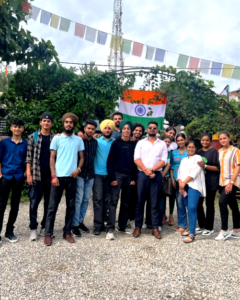Thomas Harriot: The Discovery of Refraction
A When light travels from one medium to another, it generally bends, or refracts. The law of refraction gives us a way of predicting the amount of bending. Refraction has many applications in optics and technology. A lens uses refraction to form an image of an object for many different purposes, such as magnification. A prism uses refraction to form a spectrum of colors from an incident beam of light. Refraction also plays an important role in the formation of a mirage and other optical illusions. The law of refraction is also known as Snell’s Law, named after Willobrord Snell, who discovered the law in 1621. Although Snell’s sine law of refraction is now taught routinely in undergraduate courses, the quest for it spanned many centuries and involved many celebrated scientists. Perhaps the most interesting thing is that the first discovery of the sine law, made by the sixteenth-century English scientist Thomas Harriot (1560-1621), has been almost completely overlooked by physicists, despite much published material describing his contribution.
B A contemporary of Shakespeare, Elizabeth I, Johannes Kepler and Galilei Galileo, Thomas Harriot (1560-1621) was an English scientist and mathematician. His principal biographer, J. W. Shirley, was quoted saying that in his time he was “England’s most profound mathematician, most imaginative and methodical experimental scientist”. As a mathematician, he contributed to the development of algebra, and introduced the symbols of ”>”, and ”<” for ”more than” and ”less than.” He also studied navigation and astronomy. On September 17, 1607, Harriot observed a comet, later Identified as Hailey-s. With his painstaking observations, later workers were able to compute the comet’s orbit. Harriot was also the first to use a telescope to observe the heavens in England. He made sketches of the moon in 1609, and then developed lenses of increasing magnification. By April 1611, he had developed a lens with a magnification of 32. Between October 17, 1610 and February 26, 1612, he observed the moons of Jupiter, which had already discovered by Galileo. While observing Jupiter’s moons, he made a discovery of his own: sunspots, which he viewed 199 times between December 8, 1610 and January 18, 1613. These observations allowed him to figure out the sun’s period of rotation.
C He was also an early English explorer of North America. He was a friend of the English courtier and explorer Sir Walter Raleigh and travelled to Virginia as a scientific observer on a colonising expedition in 1585. On June 30, 1585, his ship anchored at Roanoke Island ,off Virginia. On shore, Harriot observed the topography, flora and fauna, made many drawings and maps, and met the native people who spoke a language the English called Algonquian. Harriot worked out a phonetic transcription of the native people’s speech sounds and began to learn the language, which enabled him to converse to some extent with other natives the English encountered. Harriot wrote his report for Raleigh and published it as A Briefe and True Report of the New Found Land of Virginia in 1588. Raleigh gave Harriot his own estate in Ireland, and Harriot began a survey of Raleigh’s Irish holdings. He also undertook a study of ballistics and ship design for Raleigh in advance of the Spanish Armada’s arrival.
D Harriot kept regular correspondence with other scientists and mathematicians, especially in England but also in mainland Europe, notably with Johannes Kepler. About twenty years before Snell’s discovery, Johannes Kepler (1571-1630) had also looked for the law of refraction, but used the early data of Ptolemy. Unfortunately, Ptolemy’s data was in error, so Kepler could obtain only an approximation which he published in 1604. Kepler later tried to obtain additional experimental results on refraction, and corresponded with Thomas Harriot from 1606 to 1609 since Kepler had heard Harriot had carried out some detailed experiments. In 1606, Harriot sent Kepler some tables of refraction data for different materials at a constant incident angle, but didn’t provide enough detail for the data to be very useful. Kepler requested further information, but Harriot was not forthcoming, and it appears that Kepler eventually gave up the correspondence, frustrated with Harriot’s reluctance.
E Apart from the correspondence with Kepler, there is no evidence that Harriot ever published his detailed results on refraction. His personal notes, however, reveal extensive studies significantly predating those of Kepler, Snell and Descartes. Harriot carried out many experiments on refraction in the 1590s, and from his notes, it is clear that he had discovered the sine law at least as early as 1602. Around 1606, he had studied dispersion in prisms (predating Newton by around 60 years), measured the refractive indices of different liquids placed in a hollow glass prism, studied refraction in crystal spheres, and correctly understood refraction in the rainbow before Descartes.
F As his studies of refraction, Harriot’ s discoveries in other fields were largely unpublished during his lifetime, and until this century, Harriot was known only for an account of his travels in Virginia published in 1588, ,and for a treatise on algebra published posthumously in 1631. The reason why Harriot kept his results unpublished is unclear. Harriot wrote to Kepler that poor health prevented him from providing more information, but it is also possible that he was afraid of the seventeenth century’s English religious establishment which was suspicious of the work carried out by mathematicians and scientists.
G After the discovery of sunspots, Harriot’ s scientific work dwindled. The cause of his diminished productivity might have been a cancer discovered on his nose. Harriot died on July 2, 1621, in London, but his story did not end with his death. Recent research has revealed his wide range of interests and his genuinely original discoveries. What some writers describe as his “thousands upon thousands of sheets of mathematics and of scientific observations” appeared to be lost until 1784, when they were found in Henry Percy’s country estate by one of Percy’s descendants. She gave them to Franz Xaver Zach, her husband’s son’s tutor. Zach eventually put some of the papers in the hands of the Oxford University Press, but much work was required to prepare them for publication, and it has never been done. Scholars have begun to study them,, and an appreciation of Harriot’s contribution started to grow in the second half of the twentieth century. Harriot’s study of refraction is but one example where his work overlapped with independent studies carried out by others in Europe, but in any historical treatment of optics his contribution rightfully deserves to be acknowledged.
Questions 1-5
Reading passage has 7 paragraphs A-G. Choose the correct heading for paragraphs B-E and G from the list of headings below. Write the correct number, i-x, in boxes 1-5 on your answer sheet.
List of Headings
i. A misunderstanding in the history of science
ii. Thomas Harriot’s biography
iii. Unknown reasons for his unpublished works
iv. Harriot’s 1588 publication on North America studies
v. Expedition to the New World
vi. Reluctant cooperation with Kepler
vii. Belated appreciation of Harriot’s contribution
viii. Religious pressures keeping him from publishing
ix. Correspondence with Kepler
x. Interests and researches into multiple fields of study
1. Paragraph B
2. Paragraph C
3. Paragraph D
4. Paragraph E
5. Paragraph G
Questions 6-10
Answer the questions below using NO MORE THAN THREE WORDS from the passage for each answer.
Various modem applications base on an image produced by lens uses refraction, such as (6)………………. And a spectrum of colors from a beam of light can be produced with (7)……………… Harriot travelled to Virginia and mainly did research which focused on two subjects of American (8)…………………. After, he also enters upon a study of flight dynamics and (9)……………….. for one of his friends much ahead of major European competitor. He undertook extensive other studies which were only noted down personally yet predated than many other great scientists. One result, for example, corrected the misconception about the idea of (10)……………..
Questions 11-14
Look at the following researchers (listed A-D) and findings. Match each researcher with the correct finding. Write your answers in boxes 11-14 on your answer sheet. NB You may use any researcher more than once.
A Willobrord Snell
B Johannes Kepler
C Ptolemy
D Galileo
E Harriot
11. Discovered the moons of Jupiter
12. Distracted experimental calculation on refraction
13. The discovery of sunspots
14. The person whose name the sin law was attributed to
Crisis! freshwater
A As in New Delhi and Phoenix, policymakers worldwide wield great power over how water resources and managed. Wise use of such power will become increasingly important as the years go by because the world’s demand for freshwater is currently overtaking its ready supply in many places, and this situation shows no sign of abating.
B That the problem is well-known makes it no less disturbing: today one out of six people, more than a billion, suffer inadequate access to safe freshwater. By 2025, according to data released by the United Nations, the freshwater resources of more than half the countries across the globe will undergo either stress- for example, when people increasingly demand more water than is available or safe for use-or outright shortages. By mid-century, as much as three-quarters of the earth’s population could face scarcities of freshwater.
C Scientists expect water scarcity to become more common in large part because the world’s population is rising and many people are getting richer (thus expanding demand) and because global climate change is exacerbating aridity and reducing supply in many regions. What is more, many water sources are threatened by faulty waste disposal, releases of industrial pollutants, fertilizer runoff, and coastal influxes of saltwater into aquifers as groundwater is depleted.
D Because lack of access to water can lead to starvation, disease, political instability, and even armed conflict, failure to take action can have broad and grave consequences. Fortunately, to a great extent, the technologies and policy tools required to conserve existing freshwater and to secure more of it are known among which several seem particularly effective. What is needed now is action. Governments and authorities at every level have to formulate and execute plans for implementing the political, economic, and technological measures that can ensure water security now and in the coming decades.
E The world’s water problems require, as a start, an understanding of how much freshwater each person requires, along with knowledge of the factors that impede supply and increase demand in different parts of the world. Main Falkenmark of the Stockholm International Water Institute and other experts estimate that, on average, each person on the earth needs a minimum of 1000 cubic meters (m3) of water. The minimum water each person requires for drinking, hygiene, and growing food. The volume is equivalent to two-fifths of an Olympic-size swimming pool.
F Much of the Americas and northern Eurasia enjoy abundant water supplies. But several regions are beset by greater or lesser degrees of “physical” scarcity-whereby demand exceeds local availability. Other areas, among them Central Africa, parts of the Indian subcontinent, and Southeast Asia contend with “economic” water scarcity limit access even though sufficient supplies are available.
G More than half of the precipitation that falls on land is never available for capture or storage because it evaporates from the ground or transpires from plants; this fraction is called blue-water sources-rivers, lakes, wetlands, and aquifers-that people can tap directly. Farm irrigation from these free-flowing bodies is the biggest single human use of freshwater resources, but the intense local demand they create often drains the surroundings of ready supplies.
H Lots of water, but not always where it is needed one hundred and ten thousand cubic kilometers of precipitation, nearly 10 times the volume of Lake Superior, falls from the sky onto the earth’s land surface every year. This huge quantity would easily fulfill the requirements of everyone on the planet if the water arrived where and when people needed it. But much of it cannot be captured (top), and the rest is disturbed unevenly (bottom). Green water (61.1% of total precipitation): absorbed by soil and plants, then released back into the air: unavailable for withdrawal. Bluewater (38.8% of total precipitation): collected in rivers, lakes, wetlands, and groundwater: available for withdrawal before it evaporates or reaches the ocean. These figures may not add up to 100% because of rounding. Only 1.5% is directly used by people.
I Waters run away in tremendous wildfires in recent years. The economic actors had all taken their share reasonably enough: they just did not consider the needs of the natural environment, which suffered greatly when its inadequate supply was reduced to critical levels by drought. The members of the Murray-Darling Basin Commission are now frantically trying to extricate themselves from the disastrous results of their misallocation of the total water resource. Given the difficulties of sensibly apportioning the water supply within a single nation, imagine the complexities of doing so for international river basins such as that of the Jordan River, which borders on Lebanon, Syria, Israel, the Palestinian areas, and Jordan, all of which have claims to the shared, but limited, supply in an extremely parched region. The struggle for freshwater has contributed to civil and military disputes in the area. Only continuing negotiations and compromises have kept this tense situation under control.
Questions 15-19
Do the following statements agree with the information given in reading passage? In boxes 15-19 on your answer sheet, write
TRUE if the statement agrees with the information
FALSE if the statement contradicts the information
NOT GIVEN if there is no information on this
15. The prospect for the need for freshwater worldwide is obscure.
16. To some extent, the challenge for freshwater is alleviated by common recognition.
17. Researchers arrive at the specific conclusion about the water crisis based on persuasive consideration of several factors.
18. The fact that people do not actually cherish the usage of water scarcity.
19. Controversy can’t be avoided for adjacent nations over the water resource.
Questions 20-24
The reading passage has eleven paragraphs A-I. Which paragraph contains the following information?
20. The uneven distribution of water around the world.
21. Other factors regarding nature bothering people who make the policies.
22. Joint efforts needed to carry out the detailed solutions combined with various aspects.
23. No always-in-time match available between the requirements and the actual rainfall.
24. The lower limit of the amount of fresh water for a person to survive.
Questions 25-27
Complete the following summary of the paragraphs of reading passage, using NO MORE THAN THREE WORDS from the reading passage for each answer. Write your answers in boxes 25–27 on your answer sheet.
Many severe problems like starvation and military actions etc result from the storage of water which sometimes for some areas seems (25)…………… because of unavailability but other regions suffer another kind of scarcity for insufficient support. (26)……………… of the rainfall can’t be achieved because of evaporation. Some other parts form the (27)……………….. which can be used immediately. Water to irrigate the farmland takes a considerable amount along with the use for cities and industries and the extended need from the people involved.
The return of monkey life
Rain forest trees growing anew on Central American farmland are helping scientists find ways for monkey and agriculture to benefit one another.
A Hacienda La Pacifica, a remote working cattle ranch in Guanacaste province of northern Costa Rica, has for decades been home to a community of mantled howler monkeys. Other native primates- white-faced capuchin monkeys and spider monkeys were once common in this area, too, but vanished after the Pan-American Highway was built nearby in the 1950s and most of the surrounding land was cleared for cattle-raising. At Hacienda La Pacifica, however, an enlightened ranch owner chose to leave some strips of native trees growing. He used these as windbreaks to protect both cattle and their food crops from dry-season winds. In the process, the farmer unwittingly founded a unique laboratory for the study of monkeys.
B Ken Glander, a primatologist from Duke University in the USA, is studying La Pacifica’s monkeys in an effort to understand the relationship between howlers and regenerating forests at the edges of grazing lands. Studying such disturbed woodlands is increasingly important because throughout much of the New World Tropics, these are the only forests left. In the 18th century, tropical dry forests once covered most of Central America, but by the 1980s less than two percent remained undisturbed, and less than one percent was protected.
C Howlers persists at La Pacifica, Glander explains, because they are leaf-eaters. They eat fruit when it is available but, unlike capuchin and spider monkeys, do not depend on large areas of fruiting trees. Glander is particularly interested in howlers’ ability to thrive on leaves loaded with toxins- poisonous substances designed to protect the plants. For leaf-eaters, long-term exposure to a specific plant toxin can increase their ability to neutralize the poisonous substances and absorb the leaf nutrients. Watching generations of howlers at La Pacifica has shown Glander that the monkeys keep their systems primed by sampling a variety of plants and then focusing on a small number of the most nutritious food items. The leaves that grow in regenerating forests, like those at La Pacifica, are actually more howler-friendly than those produced by the centuries-old trees that survive farther south. In younger forests, trees put most of their limited energy into growing wood, leaves, and fruit, so they produce much lower levels of toxin than do well-established, old-growth trees.
D The value of maturing forests to primates is also a subject of study at Santa Rosa National Park, about 35 miles northwest of La Pacifica. Large areas of Santa Rosa’s forests had at one time been burnt to make space for cattle ranching and coffee farming, thereby devastating local monkey habitat. But in 1971 the government protected the area by designating it a National Park, and species of Indigenous Lees which had been absent for decades began to invade the abandoned pastures. Capuchins were the first to begin using the reborn forests, followed by howlers. Eventually, even spider monkeys, fruit-eaters that need large areas of continuous forest, returned. In the first 28 years following protection of the area, the capuchin population doubled, while the number of howlers increased sevenfold.
E Some of the same traits that allow howlers to survive at La Pacifica also explain their population boom in Santa Rosa, Howler reproduction is faster than that of other native monkey species. They give birth for the first time at about 3.5 years of age, compared with seven years for capuchins, and eight or more for spider monkeys. Also, while a female spider monkey will have a baby about once every four years, well-fed howlers can produce an infant every two years. Another factor is diet. Howlers are very adaptable feeders, and only need a comparatively small home range. Spider monkeys, on the other hand, need to occupy a huge home range. Also crucial is fact that the leaves howlers eat hold plenty of water, so the monkeys can survive away from open streams and water holes. This ability gives them a real advantage over capuchin and spider monkeys, which have suffered during the long, ongoing drought in the area.
F Alejandro Estrada, an ecologist at Estacion de Biologia Los Tuxtlas in Veracruz, Mexico, has been studying the ecology of a group of howler monkeys that thrive in a habitat totally altered by humans: a cacao plantation in Tabasco state, Mexico. Cacao plants need shade to grow, so 40 years ago the owners of Cholula Cacao Farm planted figs, monkeypod and other tall trees to form a protective canopy over their crop. The howlers moved in about 25 years ago after nearby forests were cut. This strange habitat seems to support about as many monkeys as would a same-sized patch of wild forest. The howlers eat the leaves and fruit of the shade trees, leaving the valuable cacao pods alone.
G Estrada believes the monkeys bring underappreciated benefits to such plantations, dispersing the seeds of fruits such as fig and other shade trees, and fertilizing the soil. Spider monkeys also forage for fruit here, though they need nearby areas of forest to survive in the long term. He hopes that farmers will begin to see the advantages of associating with wild monkeys, which could include potential ecotourism projects, ‘Conservation is usually viewed as a conflict between farming practices and the need to preserve nature,’ Estrada says. ‘We’re moving away from that vision and beginning to consider ways in which commercial activities may become a tool for the conservation of primates in human-modified landscapes.’
Question 28 – 31
Reading passage has seven paragraphs, A-G. Which paragraph contains the following information?
28. A reason why newer forests provide howlers with better feeding opportunities than older forests
29. A reference to a change in farmers’ attitudes towards wildlife
30. A description of the means by which howlers select the best available diet for themselves
31. Figures relating to the reduction of natural wildlife habitat over a period of time
Questions 32-35
Complete the summary below. Choose ONE WORD ONLY from the passage for each answer.
Why do howlers have an advantage over other Central American monkeys?
Howler monkeys have a more rapid rate of (32)………………… than either capuchin of spider monkeys. Unlike the other local monkey species, howlers can survive without eating (33)……………. and so can live inside a relatively small habitat area. Their diet is more flexible, and they are able to tolerate leaves with high levels of (34)……………… Howlers can also survive periods of (35)…………….. better than the other monkey species can.
Question 36 – 40
Look at the following features (Questions 36-40) and the list of locations below. Match each feature with the correct location, A, B or C. Write the correct letter, A, B or C, in boxes 36-40 on your answer sheet.
List of Locations
A A
B B
C C
36. It has seen the return of native tree species.
37. It supports only one species of native monkey.
38. Its monkey population helps the agriculture of the area.
39. It is home to populations of all three local monkey species.
40. Its landscape was altered by the construction of a transport link.








